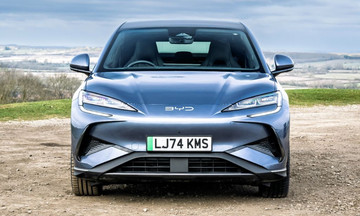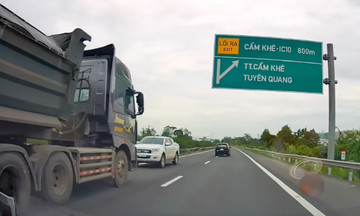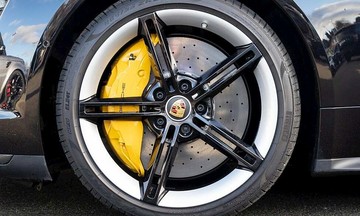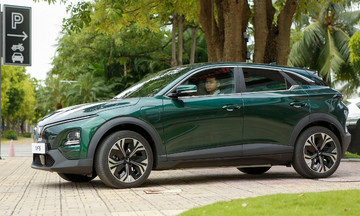China's e-bike trade-in program has significantly boosted both production and sales, positively impacting consumer spending, livelihoods, and safety, according to the Ministry of Commerce.
In the first six months of 2025, approximately 8.47 million new e-bikes were sold nationwide through the trade-in program, 6.1 times higher than the same period in 2024. Sales in Jiangsu, Hebei, and Zhejiang provinces each exceeded 1 million units, while 16 other provinces, including Anhui and Shandong, saw sales surpass 100,000 units each.
Over 400 million e-bikes are currently in use across the country, averaging one e-bike for every 3.5 people. China's total population was 1.4083 billion in 2024, according to the National Bureau of Statistics (NBS).
 |
E-bikes on display at the China International Bicycle Fair in Shanghai in May. Photo: Xinhua |
E-bikes on display at the China International Bicycle Fair in Shanghai in May. Photo: Xinhua
Suzhou and Hangzhou rank second and third nationwide in e-bike ownership, with 9.5 million and nearly 7 million respectively, trailing only Shanghai (11.83 million). Both cities have populations exceeding 10 million.
During the same period, total sales reached approximately 24.77 billion CNY (about 3.46 billion USD), a 6.6-fold increase year-on-year. Around 8.4 million buyers nationwide benefited from subsidies under this program.
Data also indicates that the e-bike industry has profited from strong production and sales under the trade-in program. In the first half of this year, output from the top 10 e-bike brands increased by 27.6% compared to the same period last year.
A total of 82,000 retail stores, mostly small businesses and individual entrepreneurs, participated in the trade-in program. The program boosted each store's sales by an average of 302,000 CNY.
Why is the demand for e-bikes higher in Jiangsu, Hebei, and Zhejiang compared to other provinces? Jiangsu and Zhejiang are major economic powerhouses, with total GDPs of 13.7 trillion CNY and 9.01 trillion CNY respectively in 2024, ranking second and fourth nationwide. A shared characteristic of these key economic provinces is the robust development of the private sector.
As the economy thrives, employment concentrates, increasing demand for both commuting and family vehicles. By 2024, the number of civilian automobiles in Jiangsu reached 25.455 million, and in Zhejiang, 20.74 million.
The rising number of cars intensifies congestion on already limited urban roads. E-bikes have quickly filled this gap, offering a low-cost, high-efficiency transportation solution. In Jiangsu cities, e-bike prevalence correlates directly with traffic congestion.
While Hebei's total GDP is lower than Jiangsu and Zhejiang, its economic development ranks 13th nationwide. Local income levels play a significant role in e-bike demand.
Nie Riming, a researcher at the Shanghai Institute of Finance and Law, told Times Weekly: "Many people cannot afford the costs of buying and maintaining a car, but they need a convenient and flexible mode of transportation, so e-bikes become the best option".
By 2024, the per capita disposable income in Zhejiang and Jiangsu reached 67,000 CNY and 55,400 CNY, ranking third and fourth nationwide. Hebei's per capita disposable income was 34,600 CNY, ranking 17th.
An e-bike costs around 2,000-3,000 CNY, far less than a car, making it an affordable and accessible transportation choice. Data from the Yunmanman platform shows that from January to November 2024, Hebei's e-bike delivery volume ranked fifth nationwide.
The surging demand for e-bikes creates new pressures on urban traffic systems. Due to frequent traffic jams and the convenience of e-bikes, even families with cars are purchasing them for transportation. E-bikes are also crucial for food delivery and express services in many cities. The increasing number of e-bikes further contributes to urban traffic congestion and a rise in traffic accidents.
Addressing this mixed traffic conflict and balancing road usage between motorized vehicles and other road users is key to urban traffic management.
 |
A parking area in Guangzhou with many electric bicycles. Photo: People's Daily |
A parking area in Guangzhou with many electric bicycles. Photo: People's Daily
In recent years, Jiangsu, Zhejiang, and other provinces have implemented e-bike management measures to mitigate the impact of the surge in e-bikes and electric cars. These include mandatory non-motorized vehicle lanes and penalties for unauthorized lane usage. Many cities require new residential buildings to include e-bike parking and are developing plans for charging infrastructure to improve convenience and safety.
Nanjing, with the highest number of e-bikes in Jiangsu, issued the "Notice on Several Measures to Support Improving Housing Quality and Optimizing Planning, Service, and Management in the City" in 2024. This policy encourages new residential communities to establish independent e-bike storage and charging areas, excluding them from floor area ratio and building density calculations.
Earlier this year, the mandatory national standard "Safety Technical Specifications for E-bikes," revised by multiple ministries, was published and will take effect on 1/9. The most significant change in the new standard is the introduction of clear requirements and restrictions on illegal modifications, speed limits, and other aspects.
My Anh (Xinhua, 163)











